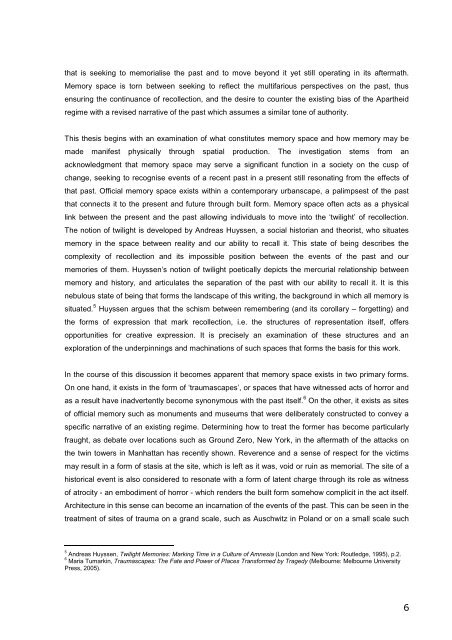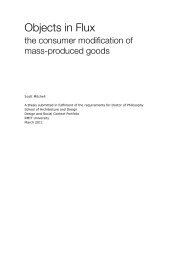Making Memory Space: Recollection and Reconciliation in Post ...
Making Memory Space: Recollection and Reconciliation in Post ...
Making Memory Space: Recollection and Reconciliation in Post ...
You also want an ePaper? Increase the reach of your titles
YUMPU automatically turns print PDFs into web optimized ePapers that Google loves.
that is seek<strong>in</strong>g to memorialise the past <strong>and</strong> to move beyond it yet still operat<strong>in</strong>g <strong>in</strong> its aftermath.<br />
<strong>Memory</strong> space is torn between seek<strong>in</strong>g to reflect the multifarious perspectives on the past, thus<br />
ensur<strong>in</strong>g the cont<strong>in</strong>uance of recollection, <strong>and</strong> the desire to counter the exist<strong>in</strong>g bias of the Apartheid<br />
regime with a revised narrative of the past which assumes a similar tone of authority.<br />
This thesis beg<strong>in</strong>s with an exam<strong>in</strong>ation of what constitutes memory space <strong>and</strong> how memory may be<br />
made manifest physically through spatial production. The <strong>in</strong>vestigation stems from an<br />
acknowledgment that memory space may serve a significant function <strong>in</strong> a society on the cusp of<br />
change, seek<strong>in</strong>g to recognise events of a recent past <strong>in</strong> a present still resonat<strong>in</strong>g from the effects of<br />
that past. Official memory space exists with<strong>in</strong> a contemporary urbanscape, a palimpsest of the past<br />
that connects it to the present <strong>and</strong> future through built form. <strong>Memory</strong> space often acts as a physical<br />
l<strong>in</strong>k between the present <strong>and</strong> the past allow<strong>in</strong>g <strong>in</strong>dividuals to move <strong>in</strong>to the ‘twilight’ of recollection.<br />
The notion of twilight is developed by Andreas Huyssen, a social historian <strong>and</strong> theorist, who situates<br />
memory <strong>in</strong> the space between reality <strong>and</strong> our ability to recall it. This state of be<strong>in</strong>g describes the<br />
complexity of recollection <strong>and</strong> its impossible position between the events of the past <strong>and</strong> our<br />
memories of them. Huyssen’s notion of twilight poetically depicts the mercurial relationship between<br />
memory <strong>and</strong> history, <strong>and</strong> articulates the separation of the past with our ability to recall it. It is this<br />
nebulous state of be<strong>in</strong>g that forms the l<strong>and</strong>scape of this writ<strong>in</strong>g, the background <strong>in</strong> which all memory is<br />
situated. 5 Huyssen argues that the schism between remember<strong>in</strong>g (<strong>and</strong> its corollary – forgett<strong>in</strong>g) <strong>and</strong><br />
the forms of expression that mark recollection, i.e. the structures of representation itself, offers<br />
opportunities for creative expression. It is precisely an exam<strong>in</strong>ation of these structures <strong>and</strong> an<br />
exploration of the underp<strong>in</strong>n<strong>in</strong>gs <strong>and</strong> mach<strong>in</strong>ations of such spaces that forms the basis for this work.<br />
In the course of this discussion it becomes apparent that memory space exists <strong>in</strong> two primary forms.<br />
On one h<strong>and</strong>, it exists <strong>in</strong> the form of ‘traumascapes’, or spaces that have witnessed acts of horror <strong>and</strong><br />
as a result have <strong>in</strong>advertently become synonymous with the past itself. 6 On the other, it exists as sites<br />
of official memory such as monuments <strong>and</strong> museums that were deliberately constructed to convey a<br />
specific narrative of an exist<strong>in</strong>g regime. Determ<strong>in</strong><strong>in</strong>g how to treat the former has become particularly<br />
fraught, as debate over locations such as Ground Zero, New York, <strong>in</strong> the aftermath of the attacks on<br />
the tw<strong>in</strong> towers <strong>in</strong> Manhattan has recently shown. Reverence <strong>and</strong> a sense of respect for the victims<br />
may result <strong>in</strong> a form of stasis at the site, which is left as it was, void or ru<strong>in</strong> as memorial. The site of a<br />
historical event is also considered to resonate with a form of latent charge through its role as witness<br />
of atrocity - an embodiment of horror - which renders the built form somehow complicit <strong>in</strong> the act itself.<br />
Architecture <strong>in</strong> this sense can become an <strong>in</strong>carnation of the events of the past. This can be seen <strong>in</strong> the<br />
treatment of sites of trauma on a gr<strong>and</strong> scale, such as Auschwitz <strong>in</strong> Pol<strong>and</strong> or on a small scale such<br />
5 Andreas Huyssen, Twilight Memories: Mark<strong>in</strong>g Time <strong>in</strong> a Culture of Amnesia (London <strong>and</strong> New York: Routledge, 1995), p.2.<br />
6 Maria Tumark<strong>in</strong>, Traumascapes: The Fate <strong>and</strong> Power of Places Transformed by Tragedy (Melbourne: Melbourne University<br />
Press, 2005).<br />
6
















